The Burren Way is certainly much less known than, for example, the Kerry Way or the Dingle Way. But sometimes a lot of beauty lies hidden!
Page Contents (click line to jump the text)
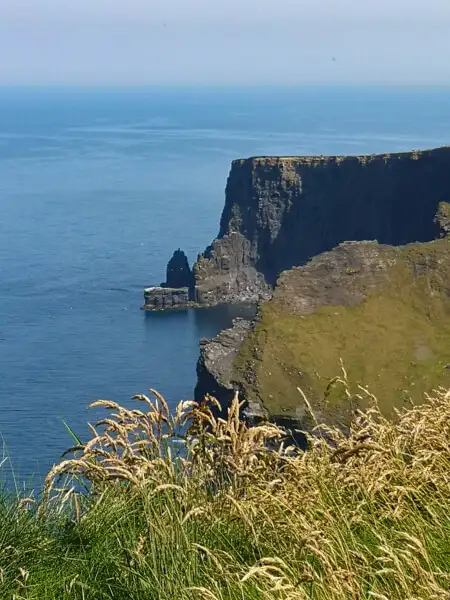
Intro
The Burren National Park is a very peculiar and unique landscape on the Irish island. Barren and karstic, the gray limestone cliffs are everywhere at first sight. The ground is rock, the hills are rock and some steep walls as well.
But on closer inspection, the wonder of nature reveals itself to the hiker – the life that makes its way even under the most adverse conditions. Between the rocks there are always green islands of grasses, herbs, wildflowers and even orchids. You can find a lot of information about this on the site of the Burren National Park.
There are many species of insects, lizards and all kinds of small animals. And above it there is an amazing variety of birds of all kinds. Occasionally feral goats roam the hills and donkeys stand in their barren pastures.
Thousands of seabirds live on the coasts, including the handsome puffins and many sea lions. And off the coasts dolphins and whales go their way. Especially at the breathtaking Cliffs of Moher, life is raging in the form of thousands of seabirds nesting on the vertical walls as you walk along a narrow path on the cliff edge, over 200 meters above the sea.
Sound interesting? Then feel free to read on:
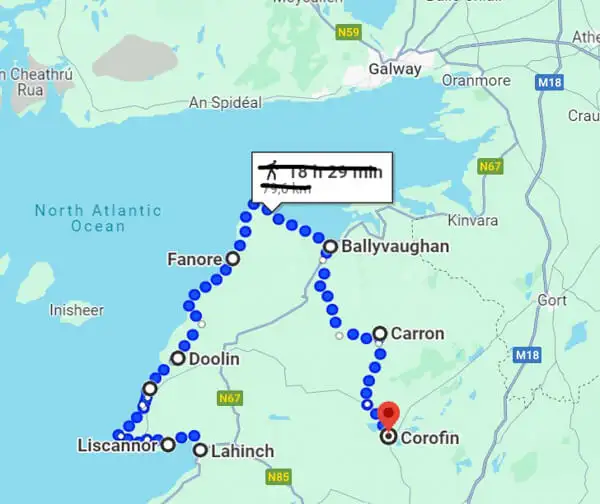
The Burren Way at a Glance
The Burren is located in the west of Ireland, just south of Galway on the Atlantic coast. The Burren Way stretches about 114 km from the seaside resort of Lahinch, along the spectacular Cliffs of Moher, along the coast of the Burren and through the karstic hills of the Burren National Park.
For this route you can allow about 5-7 days, depending on your fitness and time budget. Of course you can always shorten it. There are two loops in the northern part of the Burren Way, which you can also skip if you have only about 5 days available.

Weather and best season
The main hiking season is from April to October, with emphasis on the months of May to September.
In spring and autumn you can expect temperatures of about 12-16 degrees, in summer about 18-25 degrees.
There can always be a rain shower, as in Germany.
In winter there are more often stormy winds with a lot of persistent rain. Much more than in summer.
On the coast you always have to expect wind, even in summer.
By the way, we live in Ireland as a second home for many years now. We originate from Germany.
Tips for clothing
The well-tried onion principle also helps here: rather several thin layers of clothing than one thick one.
There can also be cool days. Good functional underwear is important. It helps to wick away sweat and keeps you warm. It requires little packing space and can also be used as pajamas.
Avoid cotton! Cotton gets damp quickly and dries poorly, thus promoting cooling. Synthetic fibers or wool-synthetic fiber blends are better.
Good hiking socks (synthetic fiber or wool-synthetic fiber) and medium-strength hiking boots are also important. You will walk partly on rough paths and the underground. can also get wet sometimes. Especially in spring and autumn I would recommend ankle-high and waterproof hiking boots.
You should always have rain gear with you. In summer at least a waterproof jacket and in the cooler season also waterproof pants.
Arrival by public transport
There is a bus terminal directly at Dublin Airport. There you can take a long distance bus to Galway and in Galway a connecting bus to Lahinch.
The other end of the trail, Corofin, is a little more difficult to reach: From Dublin Airport, take a long-distance bus to Galway, then a bus to Ennis, then a bus to Corofin. Alternatively, you can book a cab for the route Corofin-Ennis.
For schedules and tickets online, see www.citylink.ie and www.buseireann.ie.
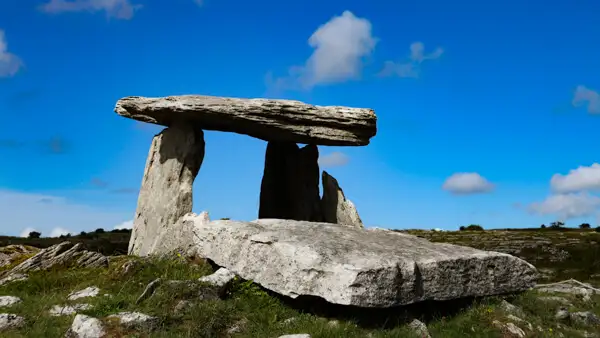
Overnight stays on the Burren Way
There are a few hostels, B&Bs and campsites around the Burren National Park, although they can be a bit scattered. Around the Cliffs of Moher there is more choice, but also more tourists.
In any case, I can only recommend to book all accommodations very well in advance, so that there are no unpleasant surprises on site.
We ourselves mostly use the apps of Booking.com and Airbnb to book accommodation. Both platforms are very common in Ireland and work very well.
If you’re thinking about wild camping, I have already written an article about it, which I will link for you at the end of this article.
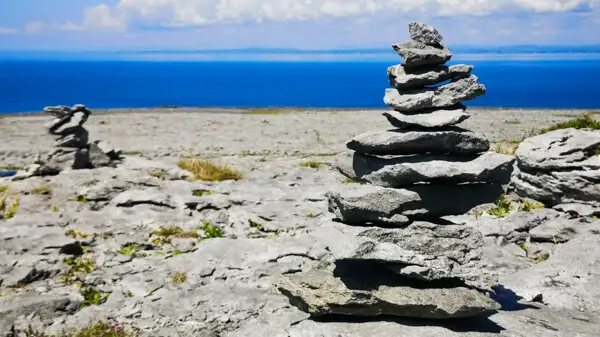
The daily stages of the Burren Way
The Burren Way is well signposted. The choice of stages is completely flexible and can be customized according to your fitness and preferences. A typical example for the daily stages I have listed here for you:
Day 1: From Lahinch to Liscannor, about 10 km.
Day 2: From Liscannor to Doolin, about 18 km.
Day 3: From Doolin to Fanore, about 18 km.
Day 4: From Fanore to Ballyvaughan, about 22 km.
Day 5: From Ballyvaughan to Carran, about 18 km.
Day 6: From Carran to Corofin, about 18 km.
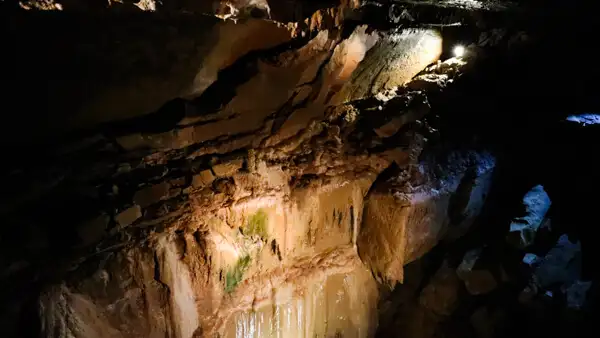
Sources of information about the Burren Way
Here I have some good sources of information for your planning:
Printed walking guides and maps
Tony Kirby, The Burren and the Aran Islands, A Walking Guide
Maps 51,52 and 57 from Ordnance Survey, scale 1:50000
Maps for download
The Irish blog Tough Soles is highly recommended. The creators, Ellie and Carl, have hiked all 40+ long distance trails in Ireland themselves and report on them. They have also made very good hiking maps for downloading and printing. You can find their maps of the Burren Way here.
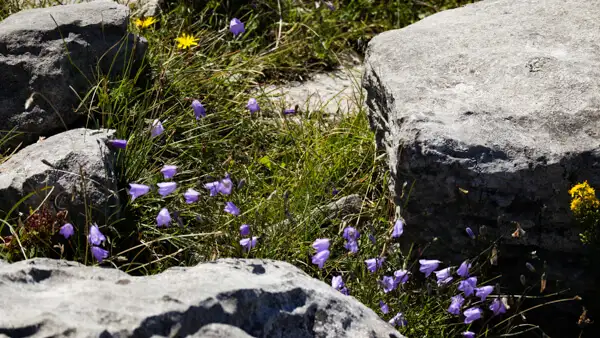
Apps for the Smartphone
There are several navigation apps that you can download to your smartphone. And they have already saved the Burren Way as electronic maps.
You can find the maps from Komoot here.
Hiiker also has maps of the Burren – click here.
Outdooractive also has maps of the Burren – click here.
Conclusion
The Burren is a unique landscape, in Ireland and in Europe. Here you will find a wild and pristine piece of nature and a unique fauna that has adapted perfectly to this peculiar habitat.
Walk through peculiar lunar landscapes and over 200 meters high on the edge of the cliffs, while below you hundreds of sea birds circle on the vertical walls of the cliffs.
Visit the caves under the Burren and admire Neolithic dolmens of people who were there some 400 years before us.
All of this is in a format that even hikers who are not out-and-out mountain walkers need not shy away from.
If this appeals to you, then the Burren Way in the Wild West of Ireland is one of the most beautiful and original hikes you can do.
So let’s go to Ireland – for hiking!
More interesting articles for you
HIKING THE WICKLOW WAY – ALL INFO FOR YOUR VACATION PLANNING
THE ULTIMATE PACKING LIST FOR MULTI-DAY HIKING IN IRELAND
THE KERRY WAY – ALL INFO FOR YOUR INDIVIDUAL HIKE
THE MOST BEAUTIFUL HIKES IN THE SOUTHEAST OF IRELAND
Photo credits cover photo: Cliffs of Moher with O´Brien´s Tower, photo by Ulrich Knüppel-Gertberg (www.irland-insider.de, www.ireland-insider.com)